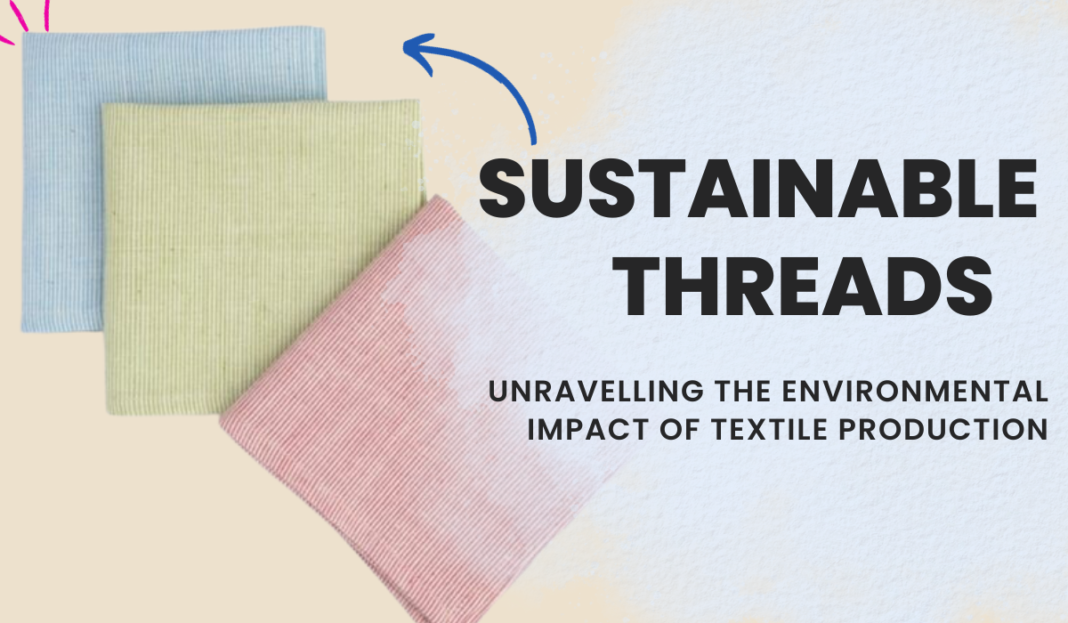Sustainable Threads: Unravelling the Environmental Impact of Textile Production
In the ever-evolving realm of fashion, where styles change in the blink of an eye, the ecological footprint of our clothing often goes unnoticed.
This article meticulously delves into the intricate environmental impact of textile production, exploring key facets ranging from raw material extraction to the global warming potential, with a focus on the vital role the textile industry plays in these dynamics.
- Sustainable Threads: Unravelling the Environmental Impact of Textile Production
- Evaluating Environmental Impact across Stages:
- 1. Raw Material Extraction:
- 2. Identifying Impact Categories:
- 3. Consumer Preferences and Organic Cotton:
- 4. Life Cycle Inventory (LCI) and Assessment Methodology:
- 5. Raw Material Selection:
- 6. Textile Production Processes:
- 7. Water Consumption:
- 8. Global Warming Potential:
- 9. International Dimensions and Standardization:
- Sustainable thread: Decoding the Environmental Symphony of Textile Production
Evaluating Environmental Impact across Stages:
1. Raw Material Extraction:
The Ammonia Shadow of Conventional Cotton The journey initiates with the extraction of raw materials, where conventional cotton cultivation leaves a considerable environmental footprint, marked by significant ammonia emissions and extensive energy use. Gomez-Campos et al’s insightful Life Cycle Assessment (LCA) on flax fibre draws attention to the often-overlooked spinning and weaving processes, revealing their contribution of over 60% to various impact categories.
2. Identifying Impact Categories:
Across Fibres nuanced analysis identifies five impact categories displaying significant variations across different fibres, underscoring the need for targeted strategies to address these variations.
3. Consumer Preferences and Organic Cotton:
Consumer behaviour becomes a pivotal aspect as Ellis, McCracken, and Skuza’s findings uncover a consumer willingness to pay a 25% premium for organic cotton t-shirts. This not only signals a market demand for sustainable choices but also reflects the economic implications of such preferences. Importantly, the study is centred on agriculture and textile production, honing in on the critical stages of a garment’s life cycle. Our Input: The Textile Industry’s Crucial Role
4. Life Cycle Inventory (LCI) and Assessment Methodology:
Delving into the textile industry’s role, we explore the concept of Life Cycle Inventory (LCI), a systematic approach quantifying environmental inputs and outputs throughout a product’s life cycle. The methodological framework underpinning Life Cycle Assessments (LCAs) is emphasized, highlighting the importance of standardized methodologies provided by the International Organization for Standardization (ISO).
5. Raw Material Selection:
A Green Battle of Choices. A comprehensive analysis unfolds as we pit organic cotton against conventional cotton and synthetic fibres. The focus is on the cultivation of organic cotton, exploring its benefits in reducing pesticide use, water consumption, and greenhouse gas emissions compared to conventional cotton and synthetic fibres.
6. Textile Production Processes:
unravelling Sustainability the manufacturing phase undergoes scrutiny, considering the production of textiles from both natural and synthetic fibres. Attention is given to energy consumption, emissions, and waste generation associated with these processes. Highlighting areas for improvement and sustainable practices becomes imperative.
7. Water Consumption:
The Drip of Sustainability Water, a critical resource in textile production, is thoroughly examined within the context of Life Cycle Assessment. The impact of water use at different stages of textile manufacturing is explored, with a dedicated focus on sustainable water management practices.
8. Global Warming Potential:
Carbon Footprints of Threads the narrative concludes by delving into the textile industry’s contribution to global warming through greenhouse gas emissions.
A comparative analysis is conducted to assess the impact of different fibres and production methods on the overall carbon footprint, bringing to light the urgency for climate-conscious choices. Beyond Borders: Australia and the Rest of the World
9. International Dimensions and Standardization:
Acknowledging the international scope of environmental standards, guided by the International Organization for Standardization (ISO), we delve into the importance of standardized approaches in shaping global best practices. Extending our exploration to Australia and the rest of the world, we recognize the interconnectedness of the environmental impact of textile production on a global scale, underscoring the need for collective responsibility.
In the intricate symphony of textile production, every note contributes to the overarching impact on our environment. This exploration navigates through the lifecycle, from raw material extraction to global implications, shedding light on the vital interplay between the textile industry and ecological sustainability.
You can also Book a 1-on-1 Call Session click here
Sustainable thread: Decoding the Environmental Symphony of Textile Production

Understanding the Life Cycle of Sustainable Threads
1. Life Cycle and Assessments:
Weaving Sustainability from Start to Finish. The textile industry’s products undergo a series of stages, prompting a comprehensive examination of their environmental journey. Life Cycle Assessments (LCAs) emerge as a key tool, dissecting each stage’s impact and fostering a holistic understanding.
2. The Organic Advantage:
Unravelling the Impact of Cotton Choices Conventional cotton extraction, a cornerstone of the industry, raises concerns with ammonia emissions and extensive energy use. The allure of organic cotton gains spotlight as it emerges as a sustainable alternative, known for reducing pesticide use, water consumption, and greenhouse gas emissions.
3. The Fibre Dilemma:
Navigating Natural and Synthetic Pathways Natural fibres, reminiscent of tradition, and synthetic fibres, epitomizing innovation, are scrutinized for their distinct environmental footprints. Fossil fuel dependency surfaces as a concern in the production of synthetic fibres, amplifying the industry’s need for sustainable alternatives.
4. The Water Tapestry:
Managing Consumption in Textile Production Water, a lifeline for textile production, becomes a focal point, necessitating a thorough examination within the context of Life Cycle Inventory. Sustainable water management practices emerge as crucial in mitigating the impact of water consumption at various stages of textile manufacturing
5. Carbon Threads:
Navigating Greenhouse Gas Emissions and Global Warming.
The textile industry’s contribution to global warming unfolds through a lens of greenhouse gas emissions. A comparative analysis assesses the carbon footprint, offering insights into the environmental impact of different fibres and production methods.
6. ISO Standards:
Framing Sustainability on an International Canvas.
The International Organization for Standardization (ISO) becomes a guiding force, providing standardized methodologies crucial for consistent Life Cycle Assessments.
Recognizing the international dimensions, we delve into Australia and the rest of the world, acknowledging the global impact of textile production.
Conclusion:
Harmonizing Threads for a Sustainable Future. As the curtain falls on this exploration, the intricate interplay of environmental keywords within textile production unravels. From raw material choices to manufacturing processes, water consumption, and greenhouse gas emissions, the textile industry stands at the crossroads of ecological responsibility. By embracing sustainable practices, weaving through standardized methodologies, and recognizing the global dimensions, the industry can harmonize its threads with the planet, crafting a sustainable legacy for generations to come. This extensive exploration of the environmental impact of textile production weaves a tapestry from raw material choices to manufacturing processes, water consumption, and greenhouse gas emissions. By unraveling these intricacies and embracing sustainable alternatives, the textile industry can stitch together a future where fashion coexists harmoniously with the planet, catering to the demands of both the present and future generations.
You can also read this blog


Kudos to the writers for highlighting sustainable threads. It’s crucial that we promote eco-friendly options in the fashion world to make a positive impact on the environment.
This article is great